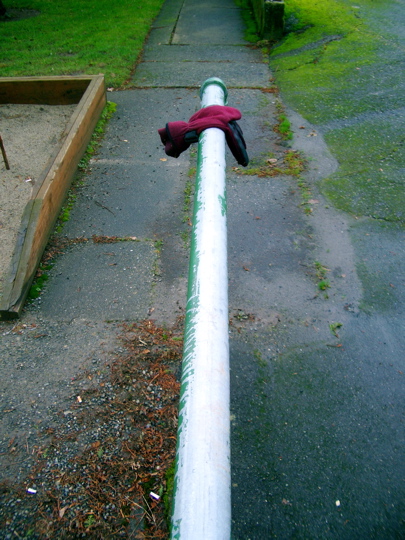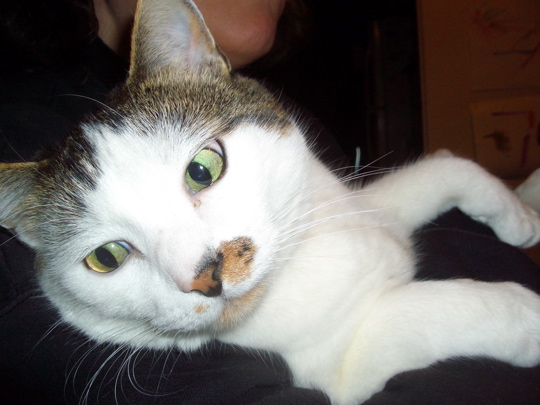January 31, 2006
Glove sighted in Vancouver
Fellow blogger Gillian Gunson alerted me to this great lost glove picture she took with her Lomo fisheye.
I almost feel bad for infecting all my readers with this lost glove meme. Once you start seeing them you pretty much can't stop.
January 27, 2006
His master's voice
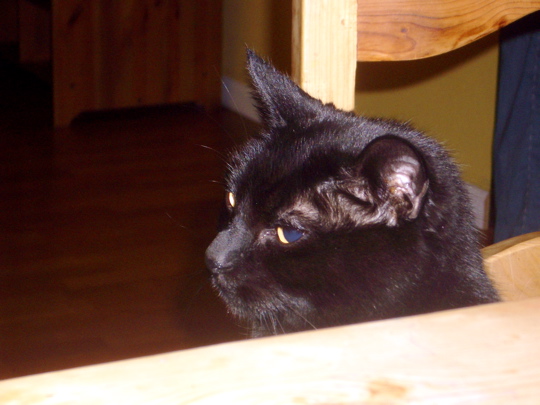
This is Cosmo. He's looking at my brother-in-law, his human. We're visiting Cosmo's house in California so he gets to be this week's feline. His sister Angie looks pretty much just like him only smaller. Angie is also more shy so she doesn't get her moment of fame this time.
January 25, 2006
Freakonomics by Steven D. Levitt and Stephen J. Dubner
 I had a gajillion different people tell me that I had to read this book. And it's certainly got interesting bits. If you're one of the few people who hasn't read the book or heard the hype, Leavitt is a relatively young and brilliant economist whose most visible skill is in asking interesting questions and then using available data to find out the real answers. Questions highlighted in the book include "Why do drug dealers still live with their moms?" and "Where have all the criminals gone?"
I had a gajillion different people tell me that I had to read this book. And it's certainly got interesting bits. If you're one of the few people who hasn't read the book or heard the hype, Leavitt is a relatively young and brilliant economist whose most visible skill is in asking interesting questions and then using available data to find out the real answers. Questions highlighted in the book include "Why do drug dealers still live with their moms?" and "Where have all the criminals gone?"
I enjoyed the book, but there were parts of it that bugged me. The main annoyance was the way that they posed questions, gave the actual answers and then told the exciting story of finding the answers. I just would have found the story much more exciting if the answer hadn't been revealed beforehand. I suppose some of the answers were so non-intuitive that I was supposed to disbelieve them until they proved them to me, but I'm really good at suspension of disbelief and read pretty much every book as if it were gospel truth (at least in the context of the book.) My other gripe is that there's really very little of an arc to the book. To their credit they warned me right up front that there wasn't going to be one. But there was kind of a half-hearted arc in that there were principles highlighted at different points that kind of felt like they might fit together in an overall theme, but didn't. I think I would have preferred it if the book had been a series of completely standalone essays.
Okay, I'm kind of being grumpy here. The book really is very interesting and brings out a lot of cool counter-intuitive results through the application of the science of economics. If you don't understand the difference between correlation and causality before you start you should have a pretty good grasp by the time you're done. Plus you'll know what some school teachers have in common with some sumo wrestlers.
January 22, 2006
Too much exercise
A friend at work is trying to talk me into riding the Chilly Hilly on February 26. It's a 33-mile bike ride on Bainbridge Island with a total of 2875 feet of altitude gain. This is a far cry from my usual day's ride which is 3 very flat miles each way.
So today I took a longer and climbier ride to see if this is even doable in a little over a month. The answer: maybe. Here's a cool map and altitude profile of today's ride using the google maps pedometer. My odometer says I rode 18 miles vs. the virtual pedometer's 16.3, but I think that's just from rounding off corners and ignoring a couple little divergences from the basic route. So there's some comparable climbing, though not as many up and downs.
I felt pretty good right up until the last three miles (which are coincidentally my normal commute) at which point I was running out of steam. This could be because I did the ride first thing in the morning (for a jeffy definition of "morning") and didn't eat before I left or along the way. Dumb, I know.
The eating issue actually points to one of the things that's going to be hardest for me in doing a ride of this length. As long-time readers will know, I've got a medical condition that makes it hard for me to swallow stuff. Some portion of any food or liquid I consume just sits in my esophagus for a long time unless I drink water for an hour after eating, or actively spit it out. This is an issue even drinking water on the bike. The last of the water stays in my throat and if I'm not careful I can accidentally inhale it especially when I'm puffing like a steam engine as I was for a large portion of this ride. It's easily fixed, I just have to spit it out, but I feel kind of self-concious about doing this around other people, and on a ride with 4,000 other cyclists there will be other people around. I guess I just need to get over it. It becomes more of an issue when I'm riding in chilly weather (and I'm probably straying into the area of Too Much Information here (as if I haven't already), so if you're squeamish, skip the rest of this paragraph...) my nose gets runny, as I assume pretty much everyone's does. Blowing your nose on the bike is pretty awkward so the natural tendency is to do some aggressive inhaling and make the drip post-nasal. That works fine if stuff in your throat gets swallowed, but not so much in my case. (I must admit that the whole mucus question is part of why I haven't taken up swimming at the local pool. Pathetic, I know.)
Okay, I'm done being gross now. I enjoyed the ride overall. It took a little under an hour and a half on the bike to do the 18 miles, and about two hours total door to door (my trip odometer only counts time when the bike is moving.) At about mile seven I stopped for a little while at the Sammamish Library and browsed a bit (picked up a stack of CDs). They have a very cool display of NW native-style wood carvings made by the students of a local woodworking school I'd never heard of, Beaver Lake WoodWorks. The pieces on display were very cool. I might have to take one of their classes! The studio where it's taught is about six miles from here, though it's up that dang hill...
January 20, 2006
Boxed set
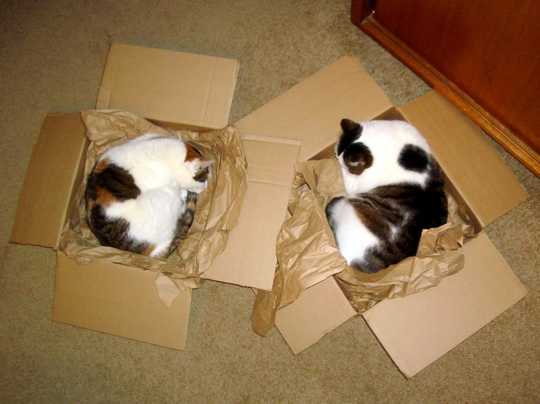
These boxes have been sitting here for more than a month and there's almost always a cat in one or the other of them.
Weight lifting for geeks
It occurs to me that I haven't mentioned my workout routine here. Back in June of last year I read an entry in Avram Grumer's livejournal about an exercise program with the unlikely name of "Shovelglove" that had something to do with a sledgehammer. Avram linked to the web page which told me this scheme was created by a guy named Reinhard Engels. I tucked the link away in del.icio.us and unlike with most things I tuck in del.icio.us I didn't promptly forget about it. In August I spent $20 at Lewis Hardware for a 10-pound sledge hammer which sat in the corner for another couple of months before I finally started using it.
The basic idea is to use the sledge hammer to make movements that are similar to those used to do real work--the kind of work people who don't sit at a desk all day do. There's a movement like you're shoveling gravel, and one like you're pounding a fence post, and a bunch of others. That's where the "shovel" part of the name comes from. The "glove" part comes from the old sweater that Engels wrapped around the business end of his sledge hammer to keep it from scratching up his floors and knocking holes in his ceiling. I've got carpeted floors and while the ceilings are low, I've carefully gauged what range of motion I can use without doing any damage to them (or the TV or the windows or the cats, though they're harder to judge) so I just use mine naked. (The sledge hammer! Not me. You people.)
The other excellent bit of design in this program is that you're supposed to wave your sledgehammer around for just 14 minutes a day and only on week days. Engels chose this timespan since it is shorter than the smallest schedulable timespan: 15 minutes. It's really hard to pretend that you can't spend 14 minutes on something.
The other thing that I like about it is that it's pretty much silent so I can do it after everyone's gone to bed without bothering anyone.
It's silly, but it really works. Not that it's saying much, but I've got more upper body strength than I've had in decades after doing this five(ish) days a week most weeks for a couple months. I actually have biceps! I still look more like a pudgy Lance than an Arnold, but I'm a geek, any upper body strength beyond what's needed to lift my coffee cup is impressive. Plus I'm getting pretty good at swinging a sledge hammer around. Now all I need is some demolition work to do.
January 16, 2006
The Straight Girl's Guide to Sleeping With Chicks by Jen Sincero
 I love living in a world where this book exists. I love living in a world where sex-positive stores like Blowfish can carry it. I love living in a world where I was able to check it out of my local public library so I could easily indulge my curiosity.
I love living in a world where this book exists. I love living in a world where sex-positive stores like Blowfish can carry it. I love living in a world where I was able to check it out of my local public library so I could easily indulge my curiosity.
In that spirit of personal freedom, how about if I put the rest of this review behind a cut so anyone who might be offended can exercise their right to change the channel before I get to the (mildly) naughty bits.
The book is exactly what you'd expect from the title. Sincero starts off explaining why a straight woman might choose to have a sexual relationship with another woman:
- the potential fluidity of role changes when both partners have the same equipment and sensibility
- the ability to keep going (and going) past climax
- the fun of simultaneously imagining what you're doing being done to you
- girls are soft and feel good
- getting to do something that makes you feel kinky
I found myself laughing out loud several times at Sincero's irreverent wit. And at the pictures. The section on positions is illustrated with photos of a pair of tattooed Barbie-style dolls.
As a straight guy who regularly sleeps with a chick, and shares all but a couple pieces of equipment with the people this book is aimed at, I expect to be able to put at least some of what I read to good use.
January 15, 2006
Transportational wisdom
Grist has a fun little interview with Kipchoge Spencer, the president of Xtracycle (the makers of the cargo bike frame extension I put on my bike last year).
He says some really sensible things both there and in the section where he answers questions from readers, but one bit in particular I thought was so well put that I wanted to highlight it. A reader asked about his car-free lifestyle and Spencer responded in part:
I started by choosing to live within biking distance of my work. I see this as a crucial eco-lifestyle choice that has its own rewards, whether or not you're car-free. I also live close to my favorite food store and to several friends. The most efficient kind of transportation is already being where you want to go.
That last sentence is just a brilliant reframe of the whole transportation conundrum.
When I'm talking to people about our car-lite lifestyle and mention that I'm just a three-mile bike ride from work they almost invariably say "You're so lucky you can do that."
My response is that luck has absolutely nothing to do with it. We live where we do precisely because it is close enough to work that I can easily bicycle. Even when we still owned a car it was important to us to be able to keep that car singular, and the best way to do that was to make sure that my bike remained a viable commute vehicle, and the best way to do that was by living close to work.
Update: Kipchoge has posted the unabridged version of the interview on his blog The Pleasant Revolution. Well worth reading the whole thing.
Lost Glove #71
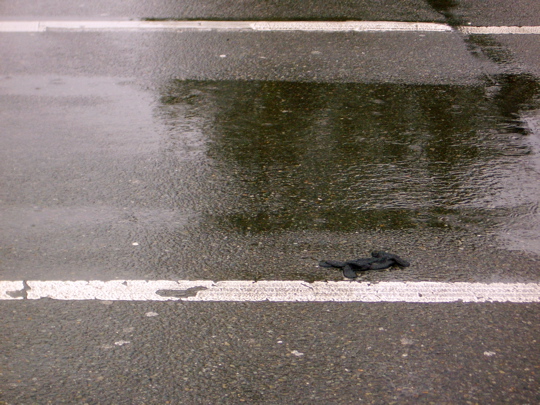
With the heavy rain we've gotten the last couple of weeks, the pedestrian underpass I usually ride to get to work has flooded so I had to take another route which led past this extremely soggy glove.
January 13, 2006
Memorial cat blogging: Oliver 1998-2006
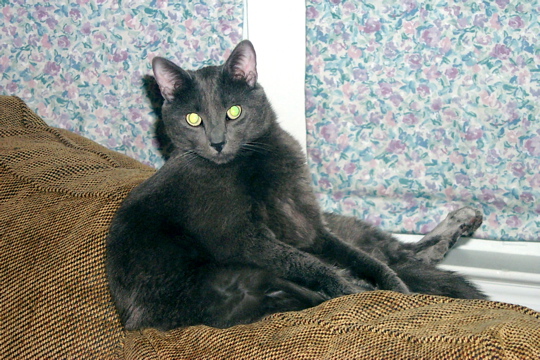
This is Oliver, one of Becky's sister Jennifer's cats. They had to have him put to sleep last Friday. Kidney failure. He was a big gentle galoot of a cat. We'll miss him.
January 11, 2006
Kris Longknife: Defiant by Mike Shepherd
 I've been calling this a military science fiction weepie. Kris Longknife is the daughter of a wealthy political family. Rather than follow the wealth-building arm of the family or the political arm, she joined the Marines. Rather than being a good little soldier she specializes in solving problems by using her natural leadership skills (and some supernaturally competent sidekicks) to foil bad guys' plots through insubordination and out-of-the-box thinking. She's kind of like Miles Vorkosigan, only without the physical handicaps. The book sees her first on a brief diplomatic misson that turns into a hostage rescue. This part of the book didn't have any connection to the later plot that I can recall. It could be that it was wrapping up some issues from one of the previous books (this is the third book in a series, but the first I've read), but it felt like a stand-alone story. Then in the rest of the book she takes command of a meager planetary defense force in an effort to repel a well-armed fleet of invading starships. So there's the military and science fiction parts of the story. The weepie part comes in because in the course of the battle all sorts of people make all sorts of personal sacrifices in an almost certainly doomed attempt to defend their home from the bad guys.
I've been calling this a military science fiction weepie. Kris Longknife is the daughter of a wealthy political family. Rather than follow the wealth-building arm of the family or the political arm, she joined the Marines. Rather than being a good little soldier she specializes in solving problems by using her natural leadership skills (and some supernaturally competent sidekicks) to foil bad guys' plots through insubordination and out-of-the-box thinking. She's kind of like Miles Vorkosigan, only without the physical handicaps. The book sees her first on a brief diplomatic misson that turns into a hostage rescue. This part of the book didn't have any connection to the later plot that I can recall. It could be that it was wrapping up some issues from one of the previous books (this is the third book in a series, but the first I've read), but it felt like a stand-alone story. Then in the rest of the book she takes command of a meager planetary defense force in an effort to repel a well-armed fleet of invading starships. So there's the military and science fiction parts of the story. The weepie part comes in because in the course of the battle all sorts of people make all sorts of personal sacrifices in an almost certainly doomed attempt to defend their home from the bad guys.
The book is written and paced well enough that it's easy to keep turning the pages, but the plot and setting felt unduly contrived to me. People follow Kris, but it's not clear why. The majority of the book is the leadup and execution of a single intricate battle scene and it was clear almost from the beginning what the outcome would be, at least to this jaded reader. It is a series, after all. A series I probably won't read any more volumes from. (And I only read this one cause I'm scoring books for the Endeavour Award again this year.)
January 08, 2006
Our year in movies
I stopped writing movie reviews here in 2004. Didn't stop watching them though. According to my calculations, Becky and/or I watched 58 movies in 2005. I'm including a table of all of them with our ratings in the extended entry.
The rating is our idiosyncratic four-star system. We don't actually talk about them as stars. What shows up here as one star we call "don't bother", two stars is "okay", three is "pretty good", four is "don't miss". We added half-star indications as a synonym for "a little better than". "Don't miss" is our highest rating.
The notes are about where we saw the movie and who saw it. "T" indicates we saw it in the theatre. Other letters indicate who attended. The default is Becky and me. If only R appears then Rachel saw it with us. If just "J" or "B" appear then only the one of us saw it. "B, R" means I skipped that one, etc.
Please feel free to comment if you have questions or want to argue about something.
The table's sorted by rating and title in case that isn't obvious ;-)
| rating | Title | Notes |
|---|---|---|
| **** | Finding Neverland | T |
| **** | Kinsey | |
| ***+ | Being Julia | |
| ***+ | Big Fish | |
| ***+ | Brokeback Mountain | T, B |
| ***+ | Eternal Sunshine of the Spotless Mind | |
| ***+ | Harry Potter and the Goblet of Fire | T |
| ***+ | A History of Violence | T, B |
| ***+ | Pride and Prejudice | T, B, R |
| ***+ | Ray | |
| ***+ | Sideways | T, B, R |
| ***+ | The Station Agent | |
| ***+ | Wallace and Gromit: the Curse of the Were-Rabbit | T |
| *** | About Schmidt | |
| *** | The Animatrix | J |
| *** | Bells Are Ringing | B |
| *** | Born Into Brothels | |
| *** | The Bourne Supremacy | |
| *** | Closer | |
| *** | Danny Deckchair | J |
| *** | Dune | scifi channel mini, J |
| *** | Elf | |
| *** | The Ghost and Mrs. Muir | B |
| *** | The House of Flying Daggers | |
| *** | The Life Aquatic with Steve Zissou | |
| *** | March of the Penguins | T, SIFF |
| *** | Mean Girls | |
| *** | Ocean's Twelve | T, B, R |
| *** | P.S. | |
| *** | The Secret Lives of Dentists | |
| *** | We Don't Live Here Anymore | |
| **+ | Cowboy Bebop | J |
| **+ | Garden State | |
| **+ | In Good Company | |
| **+ | Jersey Girl | |
| **+ | Miss Congeniality 2: Armed and Fabulous | T, B, R |
| **+ | Mr. and Mrs. Smith | T, R |
| **+ | Napoleon Dynamite | |
| **+ | Sahara | T, R |
| **+ | Serenity | T, *** after multiple viewings |
| **+ | Something's Got To Give | B |
| **+ | Spiderman 2 | |
| **+ | Star Wars III: the Revenge of the Sith | T, R |
| **+ | Thumbsucker | T |
| ** | Blast From the Past | |
| ** | Gerry | |
| ** | Greenfingers | B |
| ** | Highway | |
| ** | Silver City | |
| ** | Unconditional Love | B |
| *+ | Bridget Jones: The Edge of Reason | |
| *+ | The Hitchiker's Guide to the Galaxy | T, R |
| *+ | The Ice Harvest | T, B |
| *+ | The Ladykillers | great dvd extras |
| *+ | Raising Helen | |
| *+ | Tito and Me | J |
| *+ | Zathura | T |
jeffy's 2005 in books
Perhaps a better preposition would be "out of". By my count I finished a whopping 36 books in 2005. I believe this is the fewest books finished by quite a lot since I started keeping track in 1992. I suspect it's the fewest books finished in any year since I got my first library card.
I can't decide which was the worse culprit in this pathetic showing: time spent reading blogs and other stuff on the internet, or time spent watching tv shows on DVD. I'm not prepared to give up either of these activities altogether, but clearly a better balance must be found.
Might have to trim the blogroll a bit. I currently have 190 feeds. This week I kept track, and 110 of those feeds updated for a total of about 1200 entries. That's just one week! Normally I try to read everything dry each day so I don't notice the sheer volume of material I've been going through.
Probably should cut back a smidge on the TV show DVDs too. We've been watching Buffy and Angel regularly and in 2005 watched full seasons of Firefly and West Wing and Joan of Arcadia and Battlestar Galactica and Sex and the City (done with SatC finally). We've got seasons of Seinfeld sitting around and Northern Exposure will come from the library soon.
I'm less begrudging of the time spent watching movies. I'll summarize our year in film in another post.
Contributed glove cluster
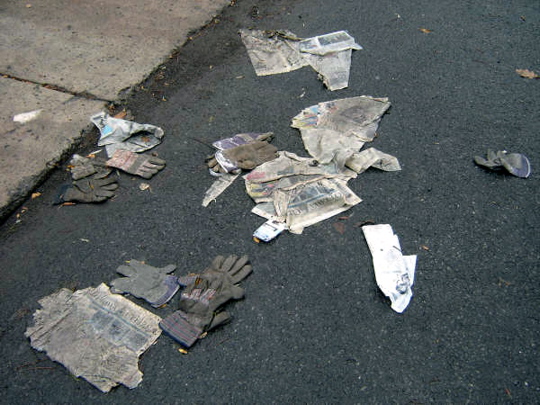
Karina Bergmans (she of the lost mitten sleeping bag) sent me this picture of an unlikely assemblage of lost gloves. (What should the collective noun for lost gloves be?)
Here's what Karina had to say about the picture:
I saw this accumulation of work gloves and took this picture for you.It was outside a hydro building or some other obscure fenced in
building that you're not sure what it is.But 10 work gloves, all piled up like that?
Must have been in the garbage and missed the truck.
Too weird!
Thanks, Karina!
And with that, we conclude this episode of lost glove catch up Sunday.
Lost Glove #69
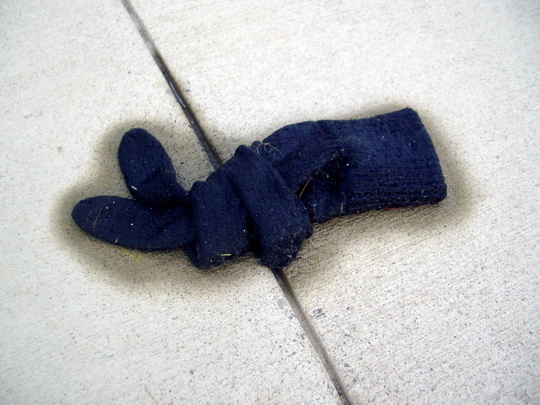
This was not the first picture I took of this glove, but it was the first picture I knew I was taking of this glove.
The first picture I took is 41 seconds into this timelapse video (10MB AVI) of my new year's day bike ride up a really big hill to the new Caffe Ladro in the Issaquah Highlands. I didn't know there was a glove in the video because at the point where I passed the glove, the only thing I was thinking about was trying to catch my breath. On my way back home I saw it and took the picture above and hence knew to look for it in the video, and lo, there it was.
Contributed glove
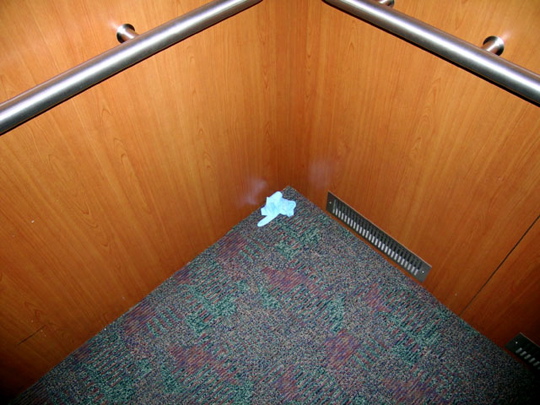
I don't usually capture disposable gloves (partly cause of the "Eww!" factor, partly cause I have to draw a line somewhere), but I'll make an exception for this one.
My dad took this picture in the elevator at the hospital while my nephew Nathan was getting himself born. (The story on that page is behind the times. Nathan is home now and doing fine)
Lost Glove #68
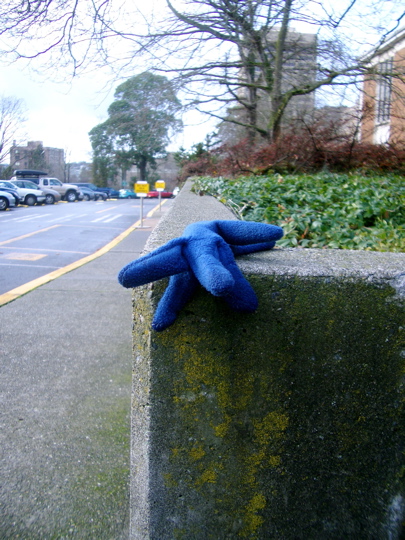
Outside the Burke Museum on Boxing Day. They had a wonderful exhibit of photos taken in the Alaska National Wildlife Refuge by Subhankar Banerjee. Follow that link back there. About a dozen of Banerjee's pictures are behind it and none of them has lost gloves in them. They're quite stunning.
Still lost
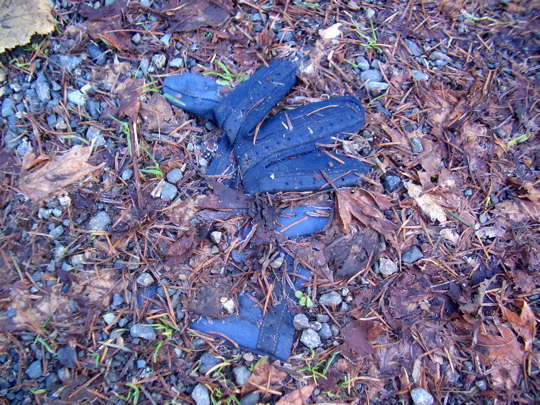
One year ago this one was sitting on a post. It moved to a nearby parking strip a few days later and has been there ever since.
Lost Glove #67
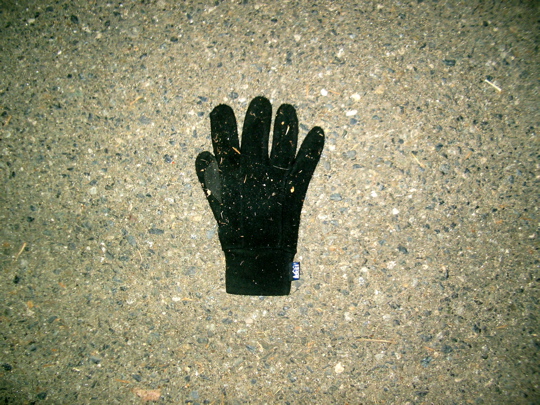
Still working off the backlog from the blog outage. This was in the middle of the three-lane road to work back on December 5th. Of course it's in a suburban office park and I took the picture at about 9pm on my way home, so there wasn't much chance I'd get run over.
January 06, 2006
January 01, 2006
Shaman's Crossing by Robin Hobb
 With this volume, Robin Hobb has graduated to that exalted sphere of authors whose names appear on the dust jackets of their books in larger type than the title (at least on my collection of US hard covers... Can't speak for when or whether this happened for other editions of her books.) This makes me happy because at least for now it means that her books are selling and so there are likely to be more of them. It also gives me hope that we may see the books written under her previous nom de plume, Megan Lindholm, reissued, which would be a very fine thing.
With this volume, Robin Hobb has graduated to that exalted sphere of authors whose names appear on the dust jackets of their books in larger type than the title (at least on my collection of US hard covers... Can't speak for when or whether this happened for other editions of her books.) This makes me happy because at least for now it means that her books are selling and so there are likely to be more of them. It also gives me hope that we may see the books written under her previous nom de plume, Megan Lindholm, reissued, which would be a very fine thing.
Shaman's Crossing is the first book in a new trilogy. It doesn't appear to be set in the same world as Hobb's previous books, but I wouldn't discard the possibility that they might be somehow linked. The setting finds an early industrial society which has almost completely subjugated a nomadic horse-riding, plains-dwelling, earth-worshipping people, and is starting to encroach on a forest-dwelling people of similar culture. The parallels to the North American conflicts between the First Nations peoples and the white man are blatant, but not precise.
The story is told in first person from the point of view of Nevare Burvelle, the son of a Gernian soldier recently promoted into landed nobility by the king following the long, bloody war with the plains people which, in turn followed a longer, bloodier war with the country of Varnia which lost Gernia their entire coastal holdings. Not a happy political climate. The culture dictates that birth order of the sons of the family strictly dictates the life pursuits of each son. The first-born is the heir, second, a soldier, third into the priesthood, fourth, the arts, etc. Nevare is a second son and so trains from his youth to be a soldier.
The first half of the book follows Nevare's early training, first with his father and a series of hired tutors, then, less conventionally, with a plainsman enemy of his father's who subjects Nevare to trials his father didn't bargain on.
The second half of the book follows Nevare to the Cavalla (read Cavalry) academy.
For much of the book I felt like I had a pretty good idea of the shape the story was going to take. This being the first book, it's not clear that I was completely wrong, but I was definitely surprised by the way this volume played out. I can't be more specific without major spoilers. I was a little disappointed by the second half of the book in that large swaths of it are fairly generic boarding school drama, but Nevare's unique personal challenges, the secondary characters, and the details of the world made it just novel enough to keep me going through all the boilerplate. Next volume should be interesting.
Raven's Strike by Patricia Briggs
 I read this book's predecessor, Raven's Shadow when I was scoring books for the 2005 Endeavour Award. It was one of my favorites of those books so when this second volume showed up on the "Choice Reads" shelf at the library, I checked it out.
I read this book's predecessor, Raven's Shadow when I was scoring books for the 2005 Endeavour Award. It was one of my favorites of those books so when this second volume showed up on the "Choice Reads" shelf at the library, I checked it out.
Again in this volume I really enjoyed the central characters, all members of one family. The fantasy setting is the other major attraction, with a well-realized system of magic where different people are born into certain fairly tightly defined magic ability flavors, each symbolized by a bird. Meadowlark for Healer, Cormorant: weather witch, Owl: bard, Eagle: guardian, Falcon: hunter, and Raven: mage. The family conveniently has members of all the orders but the healer Lark. It's also something of a mystery since not everyone is born into an order and a single family with such a concentration of order-bearers is virtually unprecedented.
The plot of Raven's Strike reveals big chunks of the world's backstory in the bounds of a fairly generic stop-the-big-bad storyline. What makes it fun are the characters, the nature of the world, and Briggs's page-turner pacing.
This volume is also distinctive for having cover art with one of the most annoyingly wrong depictions of a character from its book. The model for the woman on the cover appears to be about sixteen years old and is wearing some sort of ridiculous faux-medieval livery with flowing sleeves, a short skirt, and some kind of cape. The character who actually participated in the scene depicted is a mature, practical mother of three who wouldn't be caught dead in such an absurd costume.
The Sky Road by Ken MacLeod

The two threads are connected, of course, but how exactly is not revealed until mid-way through the book. I really liked the Clovis and Merrial thread from the beginning, but had a hard time getting traction with the Myra thread until the connection became clear (the connection wasn't really a surprise, but there was enough ambiguity about it that I didn't want to make any assumptions). MacLeod does a wonderful job of writing characters with realistic grey areas. It's not always clear who's acting in good faith. The characters themselves have to muddle through with best guesses about each other's motives. Reading a book where this is true points out how rarely books are written this way. It seems a much more interesting and honest way to tell stories about humans to me.
This book is the fourth in MacLeod's Fall Revolution series. I didn't read them in order, and it doesn't seem to be necessary to do so. I can see that rereading them in different orders is likely to throw different characters and parts of the narrative history into the spotlight. And they're worth rereading both for the characters and the fascinating future history MacLeod put together.
